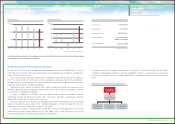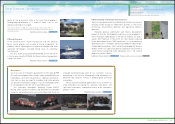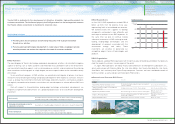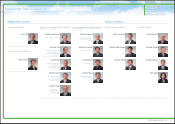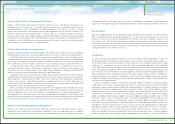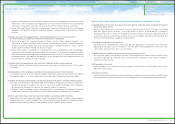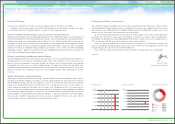Toyota 2011 Annual Report Download - page 32
Download and view the complete annual report
Please find page 32 of the 2011 Toyota annual report below. You can navigate through the pages in the report by either clicking on the pages listed below, or by using the keyword search tool below to find specific information within the annual report.
Management and
Corporate Information
Business and
Performance Review
Financial Section and
Investor InformationSpecial Feature
Message/Vision
Corporate Governance
Toyota’s Basic Policy on Corporate Governance
Toyota has positioned the stable long-term growth of corporate value as a top-priority management issue.
We believe that in carrying this out, it is essential that we achieve long-term and stable growth by building
positive relationships with all stakeholders, including shareholders and customers as well as business
partners, local communities and employees, and by supplying products that will satisfy our customers. This
position is reflected in the “Guiding Principles at Toyota,” which is a statement of Toyota’s fundamental
business policies. Also, Toyota adopted and presented the CSR Policy “Contribution toward Sustainable
Development,” an interpretation of the “Guiding Principles at Toyota” that organizes the relationships with its
stakeholders. We are working to enhance corporate governance through a variety of measures designed to
further increase our competitiveness as a global company.
Toyota’s Corporate Governance System
Toyota formulated and announced the Toyota Global Vision in March 2011, based on what it has learned from
the deterioration of the business environment following the Lehman Shock and a series of quality problems.
The Toyota Global Vision, based on Toyota’s values that have guided Toyota since its founding, such as
“Guiding Principles of Toyota” and “Toyota Way,” aims to exceed customer expectations by the development
of ever-better cars and enriching lives of societies, and to be rewarded with a smile which ultimately leads
to the stable base of business. Toyota is to keep this virtuous cycle by focusing on making ever-better cars.
To fulfill the Toyota Global Vision, Toyota made some changes to its management structure such as
reducing the Board of Directors and decision making layers. Toyota will continue to offer products and
services that will satisfy evolving needs in every region. Toyota headquarters will provide overall direction
and furnish support for the initiatives undertaken by the regional operations.
Specifically, with the aim of faster decision making, Toyota drastically reduced the number of Directors
and abolished the position of Senior Managing Director. Furthermore, Toyota will replace the current three-
layer arrangement – Executive Vice President, Chief Officer, and Executive responsible for the operations
involved – with two layers, eliminating the executive immediately below the Chief Officer. Moving forward
with this new structure will support a swifter flow of information from the divisional general managers, who
are intimately familiar with their operations, to senior management.
Toyota is to enhance clarity in organizational responsibilities: the Board of Directors decides what Toyota
will do as global Toyota, and Chief Officers decide how to implement that decision as chief executives for
day-to-day operations, etc. The post of Chief Officer will be filled either by a “Senior Managing Officer” or
“Managing Officer” in a flexible manner. Chief Officers responsible for the region or function conduct local
operations basically at respective sites under the Executive Vice President responsible for each operational
sector to vigorously reflect the voices of local customers in functions of R&D, production, and sales.
Systems for Ensuring Appropriate Management
Toyota has an “International Advisory Board” consisting of advisers from each region overseas, and, as
appropriate, receives advice on a wide range of management issues from a global perspective. In addition,
Toyota has a wide variety of conferences and committees for deliberations and the monitoring of management
and corporate activities that reflect the views of various stakeholders, including the “Labor-Management
Council,” the “Joint Labor-Management Round Table Conference” and the “Toyota Environment Committee.”
Accountability
Toyota has engaged in timely and fair disclosure of corporate and financial information as stated in the CSR
Policy “Contribution towards Sustainable Development.” In order to ensure the accurate, fair, and timely
disclosure of information, Toyota has established the Disclosure Committee chaired by an officer of the
Accounting Division. The Committee holds regular meetings for the purpose of preparation, reporting and
assessment of its annual securities report, quarterly report under the Financial Instruments and Exchange
Law of Japan and Form 20-F under the U.S. Securities Exchange Act, and also holds extraordinary committee
meetings from time to time whenever necessary.
Compliance
In order to manage and implement important activities for fulfilling social responsibilities, Toyota has
established the CSR Committee consisting of directors at the executive vice president level and above as
well as representatives of corporate auditors, to review important issues relating to corporate ethics, legal
compliance, risk management and social contribution, and also to develop action plans concerning these
issues. Toyota has also created a number of facilities for employees to make inquiries concerning compliance
matters, including the Compliance Hotline, which enables them to consult with an outside attorney, and
takes measures to ensure that Toyota is aware of significant information concerning legal compliance as
quickly as possible. Toyota will continue to promote the “Toyota Code of Conduct” which is a guideline for
employees’ behavior and conduct for employees of Toyota and its consolidated subsidiaries (together
“Toyota”) all around the world. Toyota will work to advance corporate ethics through training and education
at all levels and in all departments.
Toyota has adopted an auditor system. Seven Corporate Auditors including four Outside Corporate
Auditors play a role in Toyota’s corporate governance efforts by undertaking audits in accordance with the
audit policies and plans determined by the Board of Corporate Auditors. In addition, Toyota has secured the
personnel and framework supporting the audit by Corporate Auditors. The Outside Corporate Auditors
advise Toyota from a fair and neutral perspective, based on their broad experiences and insight in their
respective fields of expertise. The state of internal controls and internal audits are reported to Corporate
Auditors (including Outside Corporate Auditors) through the Board of Corporate Auditors and the “CSR
Committee,” and the status of accounting audits is reported by independent External Auditors to the
Corporate Auditors (including Outside Corporate Auditors) through the Board of Corporate Auditors. To
enhance the system for internal audits, a specialized organization made independent of direct control by the
management evaluates the effectiveness of the system to secure the appropriateness of documents
regarding financial calculation and other information in accordance with Section 404 of the U.S. Sarbanes-
Oxley Act and Article 24-4-4 (1) of the Financial Instruments and Exchange Law of Japan. In order to
enhance the reliability of the financial reporting of Toyota, the three auditing functions — audit by Corporate
Auditors, internal audit, and accounting audit by Independent External Auditors — aid in conducting an
0819
R&D and Intellectual Property
Corporate Philosophy
Management Team
Corporate Governance
Risk Factors
Other Management and Corporate Data
32TOYOTA ANNUAL REPORT 2011


